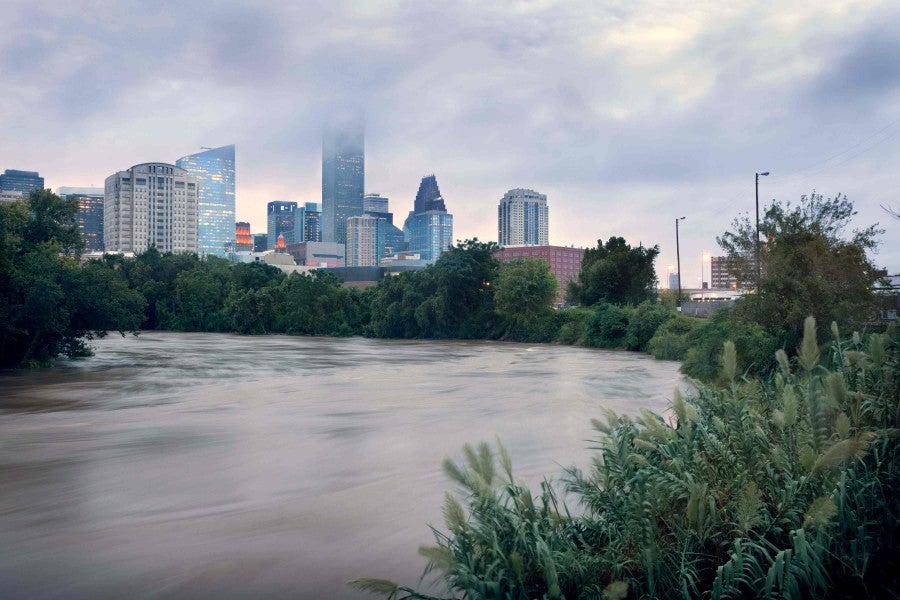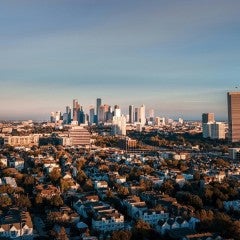This post is part of a series highlighting the findings from the 2024 Kinder Houston Area Survey.
The fast-moving, straight-line wind event caused eight fatalities. While the official monetary cost of damages has not been published, estimates in the billions are not unrealistic.
Earlier that day, a meeting of the Houston Ready working group was convened by disaster recovery expert Angela Blanchard and Mayor John Whitmire. Among the speakers was Francisco Sánchez Jr., the associate administrator in the U.S. Small Business Administration’s Office of Disaster Recovery and Resilience. Sánchez previously served in Harris County government as its deputy homeland security and emergency management coordinator.
“Talk about timely,” Sánchez said. “There we were together, figuring out how to be ready for the next disaster, and it was just hours away.”
On May 20, four days after the storm, the 43rd Kinder Houston Area Survey was released, featuring numerous findings on how residents think climate change will impact the region’s economy and people’s lives.
Nearly 60% of respondents said they were either “worried,” “very worried” or “extremely worried” about the impact of climate change on the region. Eighty-six percent said it was at least somewhat likely their quality of life would be compromised by climate change. The same percentage of residents believe that Houston’s economic prosperity will be affected.
Given that the SBA’s role in disaster recovery goes far beyond assisting businesses — it is the largest source of funds for all survivors — the Urban Edge spoke with Sánchez about the importance of community coordination and the need for financial resources to meet the looming threat. The interview has been edited for length and clarity.
What were your takeaways from the Houston Ready meeting?
The biggest thing we walked away with from that meeting was that people knew each other. We knew our priorities, and we knew what we needed to do collectively as a team to respond and recover to a disaster. That’s no minor feat. Oftentimes, disaster is a pickup game. Who’s available now? There’s no time to build relationships in an effective way immediately after the storm. People walked away with a sense of refreshed trust or a new level of trust and acquaintance with one another. We have seen over the past few years a change in leadership in some of the major nonprofit organizations that are the backbone of our recovery.
People might not immediately think of the SBA when it comes to disasters. What role does it play?
The SBA handles underinsured losses of private property for homeowners, renters, businesses and private nonprofits. The SBA story is often undertold. Most people didn’t know SBA had any role in disasters until COVID. Just as an example, Houston’s entertainment industry benefited from the Shuttered Venue Operators Grant program administered by the SBA during COVID. That program allocated over $163 million to more than 100 institutions in Houston, and Houston Symphony alone received over $7 million.
Eighty percent of our disaster lending goes to homeowners and renters, and only about 20% typically goes to businesses. The reason we’re focused on that is because a critical part of our businesses is their employees and their customers. We need to make sure the entire community is recovering.
I look at my role as replacing repetitive loss with economic opportunity. We see by and large the same communities being impacted over and over. So how do we make sure that when we’re rebuilding small businesses and the economy, that they not only get over the immediate disaster, but also strengthen them in the face of storms to come? That means giving capital as quickly as possible to be able to recover, and also making sure that they have mitigation options. It’s about looking at resilience in a much broader perspective. It’s not just rebuilding a structure the way it was before. How do we make a business more resilient in the larger picture? The SBA is about capital, counseling, contracting and disaster recovery.
How has the SBA evolved over time?
We used to be a “lend and leave” organization. We’d come in, do long-term disaster low-interest loans and be out the door. As we see the increasing consequences of climate change and the number of $1 billion disasters increase year after year, we’re living up to what our expectation is and making sure we’re utilizing every authority that we can. The base of that is long-term, low-interest loans.
For homeowners who went through this disaster, they could receive a 2.68% interest loan over 30 years. For a business, it’s as low as 4% interest over 30 years. In this market, that’s the kind of access to capital that people need. It’s cheaper than your favorite hardware store credit card. It’s cheaper than what the bank and contractors are going to finance you at. We have implemented a 12-month deferment with 0% interest. What that 12-month, 0% deferment does is allow people to focus on what matters most, and that’s their own personal recovery.
How does Houston become more resilient to climate change from an economic perspective?
Houston is home and I’ll be back when my role with the SBA is over. But when I come back, it has helped me see the community in a different way. I was going through the Texas Medical Center, and a few thoughts came to mind. Even during Hurricane Harvey, trillions of gallons of water fell, and the Medical Center had barely any flooding. That speaks to what we can do as a community. If state, local, federal, business and nonprofit organizations join together to invest in the resilience of an incredibly valuable asset that is the Medical Center, what if we apply that approach to invest in the resilience of the human capital and the things that mean the most to this community? We need that kind of energy that we built to protect the Medical Center and to apply it across the region. Imagine the beacon of economic opportunity that Houston and Harris County can become.



